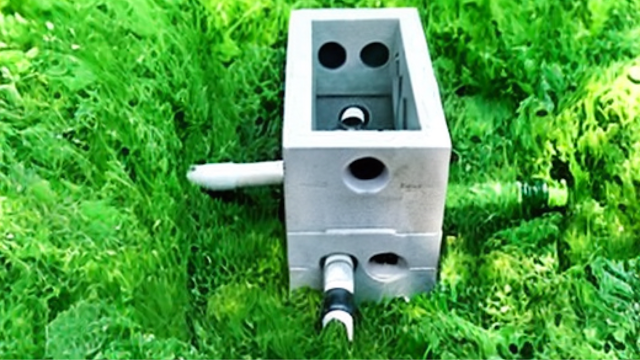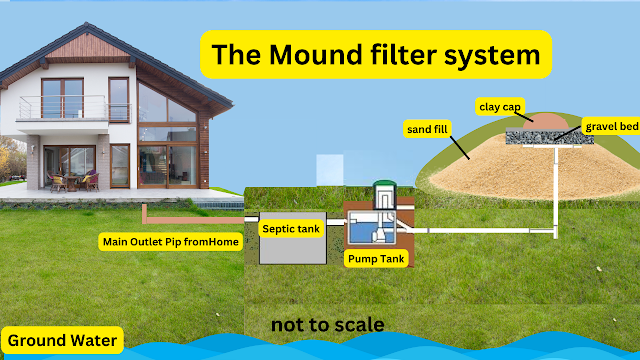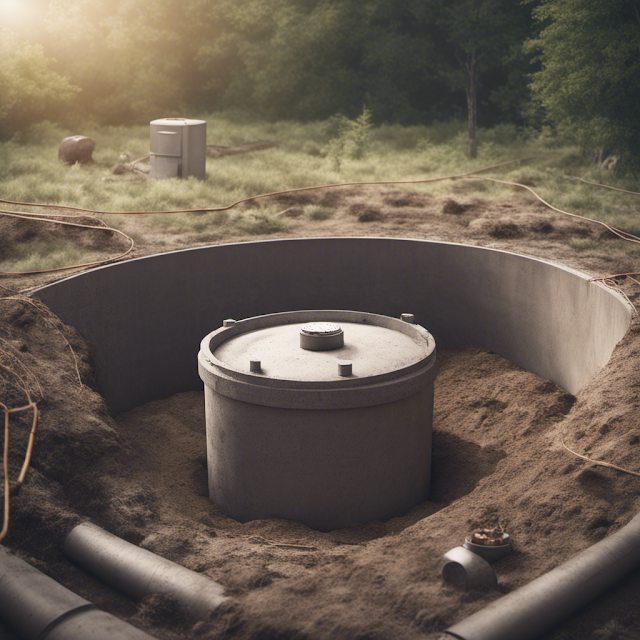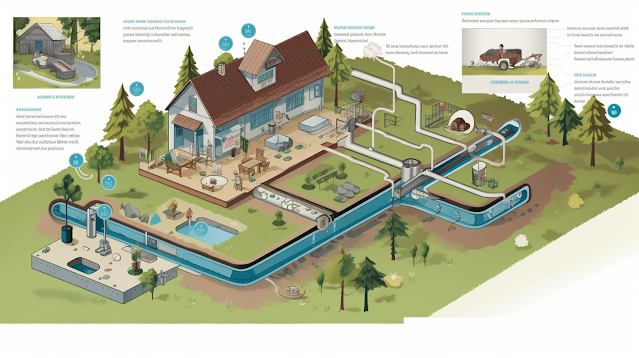Types of Septic Tank Materials
 |
| The Best Types of Septic Tank materials? |
Introduction
Septic tanks are an essential component of any wastewater management system, especially in rural areas without access to centralized sewer systems. The choice of septic tank material can significantly impact the system's durability, performance, and cost-effectiveness. In this comprehensive guide, we will discuss the various septic tank materials, including their properties, advantages and disadvantages, maintenance requirements, and other factors to consider when making your decision for a septic tank.
Our comprehensive guide includes everything from selecting the most suitable system to avoiding common issues that may arise during the installation or maintenance of your septic tank. If you're ready to give your septic system the attention it deserves, check out our unique guide available on our blog, "The Septic Tankers."
Our guide is tailored to help homeowners understand the various nuances of septic systems and take the necessary steps to keep their system functioning efficiently. As part of our guide, we've put together a rundown on the different types of septic tank materials, so you can make an informed decision when it comes to choosing the right materials for your septic system.
Concrete Septic Tanks
Properties of Concrete
Concrete is a really popular and versatile material for many reasons made from a mixture of cement, sand, and aggregates such as crushed rock or gravel. When combining, these materials they form a really dense and robust material that can stand upto harsh conditions and heavy loads above them.
Advantages of Concrete Septic Tanks
Durability: Concrete septic tanks have a reputation for their long life compared to other materials see the chart for comparisons. When they are properly maintained, they can last up to 40-plus years or even longer. Their durability stems from the inherent superior strength and stability of concrete as a robust material, making it less susceptible to damage caused from the environmental factors or any ground movement around them.
Strength: Concrete tanks have the ability to handle heavy loads, making them suitable for high-traffic areas and large vehicles. This strength is especially beneficial if you have heavy equipment or vehicles regularly passing over the septic tank location.
Chemical resistance: Concrete is highly resistant to most chemicals, which helps to prevent corrosion and prolong the tank's lifespan. This resistance means that concrete septic tanks are less likely to be affected by the various chemicals found in household waste, including cleaning products and detergents.
Buoyancy resistance: Due to their weight, concrete tanks are less likely to "float" in areas with a high water table. The heavy nature of concrete septic tanks means they are more stable in the ground, reducing the risk of tank movement or damage due to buoyancy forces.
 |
| concrete septic tank being craned in |
Weight: One of the most significant drawbacks of concrete septic tanks is their weight. Their heavy nature requires specialized equipment and professional installation, making them more expensive and labor-intensive than other materials. The weight also means that the installation process may take longer, as additional care must be taken to ensure proper placement and to prevent damage to the tank during installation.
Cracking: Over time, concrete tanks may develop cracks, which can lead to leaks and eventual failure. These cracks can be caused by factors such as ground movement, temperature fluctuations, and the natural aging process. Regular inspections are essential to detect and repair cracks early, preventing further damage and potential environmental contamination.
Environmental impact: The production of cement, a primary component of concrete, contributes significantly to greenhouse gas emissions. Cement production is an energy-intensive process, and the mining of raw materials can result in habitat destruction and resource depletion. If you are concerned about the environmental impact of your septic tank choice, you may want to consider alternatives such as plastic or fiberglass.
Maintenance and Care of Concrete Septic Tanks
To maximize the lifespan and efficiency of your concrete septic tank, regular maintenance and care are essential. This maintenance should include routine inspections for cracks or leaks, as well as monitoring the tank's overall condition. In addition to inspections, proper use and care of the septic system as a whole can help to extend the life of your concrete tank.
Here are some tips for maintaining your concrete septic tank:
Have your septic tank pumped regularly: The recommended pumping frequency will depend on factors such as the size of your tank, the number of people in your household, and the amount of wastewater generated. As a general rule, septic tanks should be pumped every 3-5 years.
Avoid pouring harsh chemicals down the drain: Chemicals like bleach, drain cleaners, and other harsh cleaning products can disrupt the balance of beneficial bacteria in your septic system, reducing its efficiency and potentially damaging your concrete tank. Opt for eco-friendly cleaning products and limit the use of chemical-based cleaners.
Conserve water: Implementing water conservation measures, such as fixing leaks, installing low-flow fixtures, and spacing out laundry loads, can reduce the strain on your septic system and extend the life of your concrete tank.
Monitor the drain field: Regularly inspect the area around your septic tank and drain field for signs of standing water, soggy soil, or unpleasant odors. These can be indicators of a problem with your septic system, which should be addressed promptly.
Schedule regular inspections: Have a septic system professional inspect your tank and system at least once every three years. These inspections can help identify potential issues, such as cracks or leaks, before they become major problems.
Fiberglass Septic Tanks
Properties of Fiberglass
Fiberglass is a lightweight, durable material made from glass fibers embedded in a resin matrix. It is highly resistant to corrosion and has a smooth surface that can help reduce the buildup of solids and sludge.
Advantages of Fiberglass Septic Tanks
Lightweight: Fiberglass septic tanks are much lighter than their concrete counterparts, making them easier to transport and install. The reduced weight can also minimize the risk of damage during installation, as well as reduce labor and equipment costs.
Corrosion resistance: Fiberglass tanks are highly resistant to both internal and external corrosion, which can help extend their lifespan. This resistance is particularly beneficial in areas with acidic soil or water conditions, where other materials might degrade more quickly.
Low maintenance: Fiberglass tanks require less maintenance than concrete or steel tanks due to their corrosion resistance and smooth surface. The smooth interior helps prevent the buildup of sludge and solids, which can reduce the frequency of pumping and cleaning.
Leak prevention: Fiberglass tanks are typically manufactured as a single, seamless unit, which reduces the risk of leaks at seams or joints. This seamless construction can help prevent environmental contamination and extend the life of your septic system.
Disadvantages of Fiberglass Septic Tanks Higher initial cost: Fiberglass septic tanks tend to be more expensive upfront than concrete or plastic tanks. However, their lower maintenance requirements and longer lifespan may offset the higher initial cost over time.
Susceptibility to damage: Fiberglass tanks can be more susceptible to damage from heavy loads or impacts compared to concrete tanks. Proper installation and care, including avoiding driving heavy vehicles over the tank area, can help prevent damage.
Limited size options: Fiberglass tanks may not be available in as many size options as concrete or plastic tanks, which could be a consideration if you have specific size requirements or space constraints.
 |
| fiberglass septic tank |
Fiberglass septic tanks require regular maintenance and care to ensure their longevity and performance. This maintenance includes regular pumping, inspections, and proper use of the septic system. Here are some tips for maintaining your fiberglass septic tank:
Pump your tank regularly: As with concrete tanks, it's essential to have your fiberglass septic tank pumped every 3-5 years, depending on factors like tank size and household water usage.
Schedule routine inspections: Have a septic system professional inspect your tank and system at least once every three years to identify any potential issues, such as damage or leaks.
Use eco-friendly cleaning products: Limit the use of harsh chemicals in your household to maintain the balance of beneficial bacteria in your septic system and prevent damage to your fiberglass tank.
Conserve water: Implement water conservation measures, such as fixing leaks, installing low-flow fixtures, and spacing out laundry loads, to reduce the strain on your septic system and extend the life of your fiberglass tank.
Avoid driving heavy vehicles over the tank area: Fiberglass tanks can be more susceptible to damage from heavy loads, so avoid driving heavy vehicles or placing heavy objects over the tank location.
Plastic Septic Tanks
Properties of Plastic
Plastic septic tanks are typically made from high-density polyethylene (HDPE) or polypropylene, which are durable, lightweight, and resistant to corrosion. Plastic tanks are available in a variety of shapes and sizes, making them a versatile option for various applications.
Advantages of Plastic Septic Tanks
Lightweight: Plastic septic tanks are significantly lighter than concrete or fiberglass tanks, making them easier to transport and install. This reduced weight can also minimize the risk of damage during installation and lower labor and equipment costs.
Corrosion resistance: Like fiberglass tanks, plastic septic tanks are highly resistant to both internal and external corrosion, which can help extend their lifespan. This resistance is particularly beneficial in areas with acidic soil or water conditions, where other materials might degrade more quickly.
Affordable: Plastic septic tanks tend to be more affordable upfront than concrete or fiberglass tanks, making them a cost-effective option for homeowners on a budget.
Variety of sizes and shapes: Plastic tanks are available in a wide range of sizes and shapes, allowing for greater flexibility in choosing a tank that best suits your property and septic system requirements.
Disadvantages of Plastic Septic Tanks
Less durable: Plastic septic tanks may not be as durable as concrete or fiberglass tanks, with a shorter average lifespan of 20-30 years. However, proper installation and maintenance can help extend the life of a plastic tank.
Susceptibility to damage: Plastic tanks can be more prone to damage from heavy loads or impacts compared to concrete or fiberglass tanks. Care should be taken to avoid driving heavy vehicles over the tank area and to protect the tank from potential damage during installation.
Buoyancy issues: Plastic tanks are more susceptible to "floating" in areas with a high water table due to their lightweight nature. Proper installation, including the use of anchors or ballast, may be necessary to prevent tank movement or damage due to buoyancy forces.
 |
| plastic sceptic tank |
Maintaining your plastic septic tank involves similar steps to those for concrete and fiberglass tanks, including regular pumping, inspections, and proper use of the septic system. Here are some tips for maintaining your plastic septic tank:
Pump your tank regularly: As with concrete and fiberglass tanks, it's essential to have your plastic septic tank pumped every 3-5 years, depending on factors like tank size and household water usage.
Schedule routine inspections: Have a septic system professional inspect your tank and system at least once every three years to identify any potential issues, such as damage or leaks.
Use eco-friendly cleaning products: Limit the use of harsh chemicals in your household to maintain the balance of beneficial bacteria in your septic system and prevent damage to your plastic tank.
Conserve water: Implement water conservation measures to reduce the strain on your septic system and extend the life of your plastic tank.
Avoid driving heavy vehicles over the tank area: Like fiberglass tanks, plastic tanks can be more susceptible to damage from heavy loads, so avoid driving heavy vehicles or placing heavy objects over the tank location.
Conclusion
When choosing a septic tank material for your property, it's essential to consider factors such as durability, weight, cost, and maintenance requirements. Concrete, fiberglass, and plastic septic tanks each have their own unique advantages and disadvantages, so it's crucial to weigh these factors against your specific needs and preferences.
Concrete tanks offer excellent durability and strength, making them a popular choice for many homeowners. Fiberglass tanks are lightweight, corrosion-resistant, and require minimal maintenance, making them an attractive option as well. Plastic tanks, on the other hand, provide affordability and versatility in size and shape, which can be appealing to those on a budget or with specific space constraints.
Ultimately, the best septic tank material for your property will depend on your individual needs, preferences, and budget. By understanding the properties and advantages of each material, you can make a well-informed decision and ensure a reliable and efficient septic system for your home.
Note: In the past, steel septic tanks were a common choice for many homeowners because of their strength. But, over time, people began to see the problems and realized that they came with a significant downside - corrosion. As these tanks were exposed to moisture, chemicals in the soil, and the wastewater inside, they soon started to rust and rot away. This led to leaks, which eventually caused the tanks to fail, and leave a large expense to replace them.
Steel septic tanks demanded more maintenance and had to be replaced more frequently compared to the superior tanks made from,concrete, fiberglass, or plastic tanks. Nowadays, homeowners are opting for alternatives that offer better longevity and lower maintenance costs. That's why you don't see steel septic tanks used that much if at all anymore; they just don't stand the test of time like other materials do.
FAQs
What is the average lifespan of each type of septic tank material?
Concrete septic tanks can last upwards of 40 years or more when properly maintained. Fiberglass tanks have a similar lifespan, while plastic tanks tend to have a shorter average lifespan of 20-30 years.
How often should I have my septic tank pumped?
As a general rule, septic tanks should be pumped every 3-5 years. However, factors such as tank size, the number of people in your household, and the amount of wastewater generated can impact the recommended pumping frequency.
Are there any environmental considerations when choosing a septic tank material?
Yes, the production of cement, a primary component of concrete, contributes significantly to greenhouse gas emissions and resource depletion. If you are concerned about the environmental impact of your septic tank choice, you may want to consider alternatives such as plastic or fiberglass.
What factors should I consider when choosing the size of my septic tank?
The size of your septic tank should be based on factors such as the number of people in your household, the size of your property, and the estimated daily wastewater flow. Consult with a septic system professional to determine the appropriate size for your needs.
Can I install a septic tank myself, or do I need a professional?
Septic tank installation is a complex process that requires specialized knowledge and equipment. It is highly recommended to consult with a septic system professional for proper installation and to ensure the safety and longevity of your septic system.
Research and Fact checked:
.png)



.png)






Comments
Post a Comment